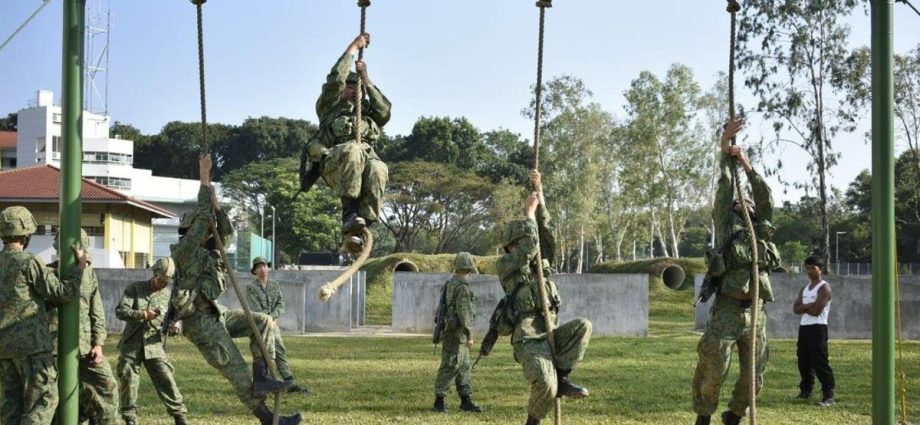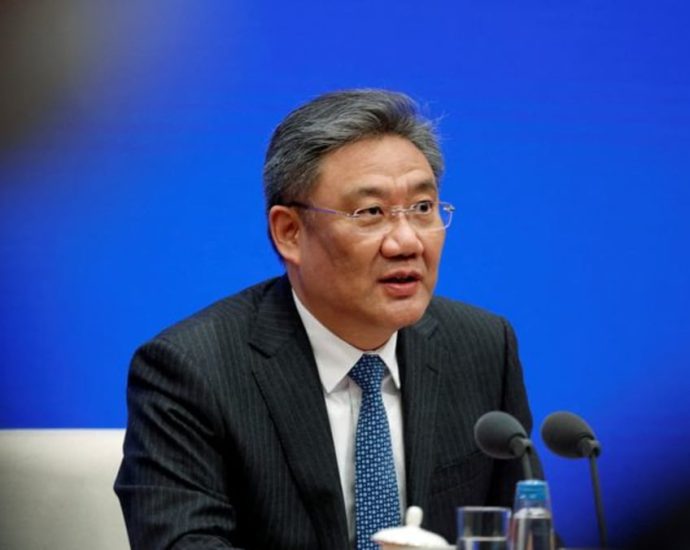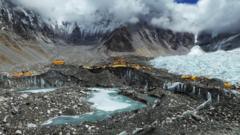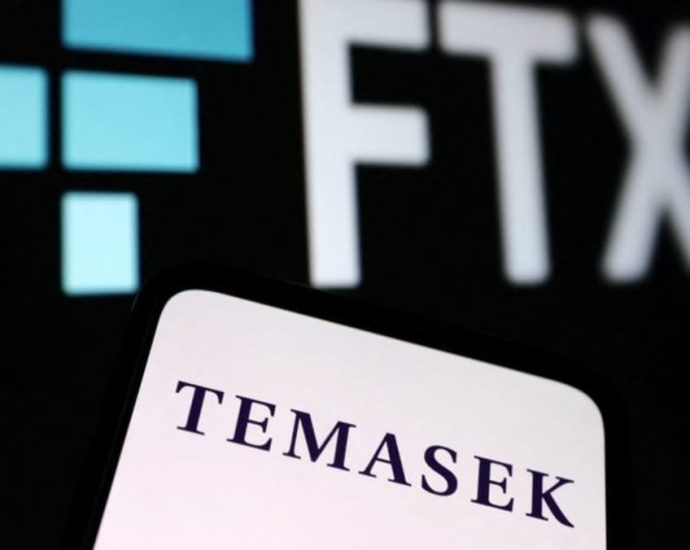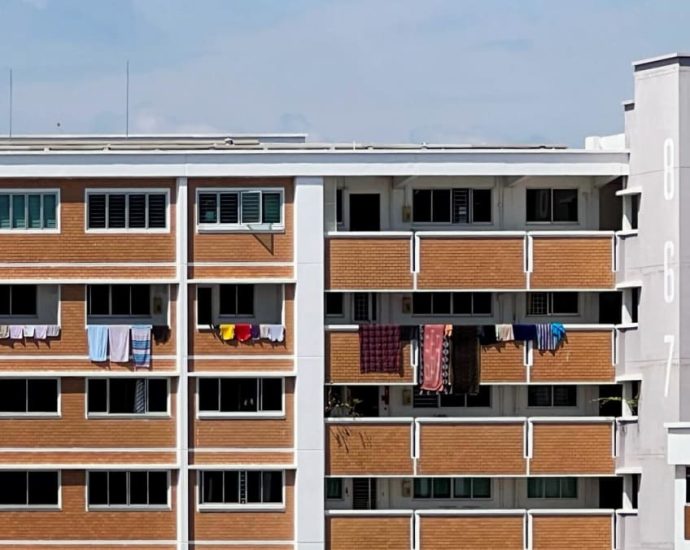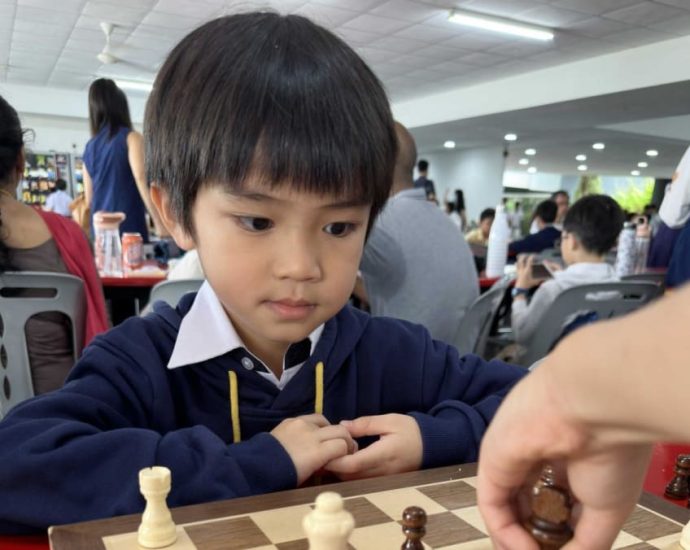All national servicemen to get up to S$200 increase in NS allowance
SINGAPORE: All national servicemen in the Singapore Armed Forces (SAF), Singapore Police Force (SPF) and Singapore Civil Defence Force (SCDF) will receive a S$125 (US$92) to S$200 increase in their National Service (NS) allowance. The increase will take effect on Jul 1 and is dependent on their rank and vocation,Continue Reading
China urges Japan to halt export restrictions on chips
BEIJING: Chinese Commerce Minister Wang Wentao urged Japan to halt semiconductor export controls, calling it a “wrongdoing” that “seriously violated” international economic and trade rules, a statement from his ministry said on Monday (May 29). China’s latest condemnation of the export restrictions was made during Wang’s talks with Japanese TradeContinue Reading
Customers report issues with StarHub TV broadcast on final weekend of English Premier League fixtures
SINGAPORE: Customers reported issues with StarHub’s broadcast service on Sunday (May 28) during the final weekend of the English Premier League season. Data on the DownDetector website showed outage reports starting shortly before the 11.30pm kickoff time for the 10 matches, spiking to more than 2,400 reports at about 11.37pm.Continue Reading
Why Everest base camp won’t be moving anytime soon
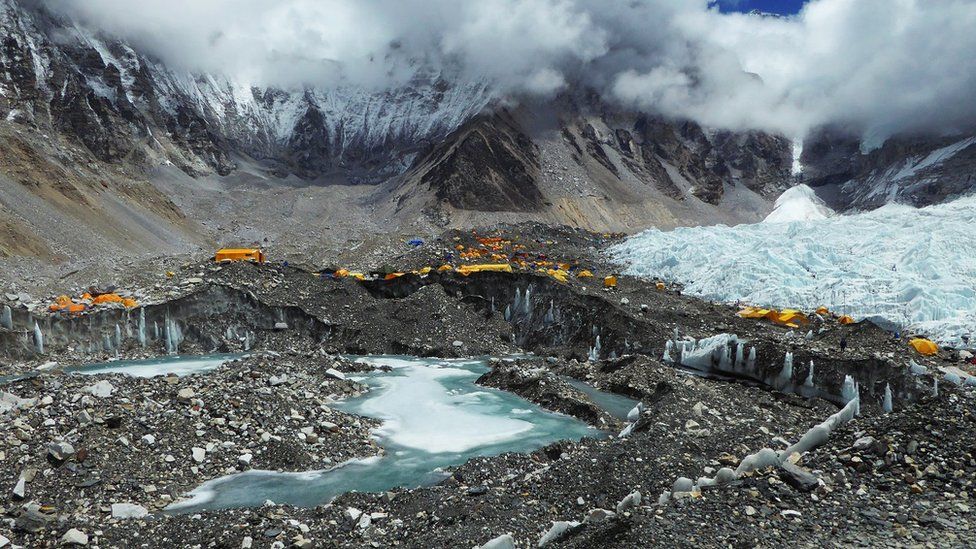 C. Scott Watson
C. Scott Watson Last June, Nepal’s tourism ministry announced plans to move Everest base camp lower down the famous mountain because global warming and human activity were making it unsafe.
The camp sits on the Khumbu glacier which is thinning rapidly, creating risks for the hundreds of climbers who pass through every year.
But following opposition from the Sherpa community and other mountaineering operators, the idea has been shelved.
Sherpa leaders told the BBC the move was impractical and that there was no viable alternative location.
As the backbone of the mountaineering industry, the Sherpa’s voice is crucial. Opposition to the move is widespread – more than 95% of attendees rejected the idea at a recent consultation with the mountaineering industry, say tourism ministry officials and the Nepal Mountaineering Association.
Officials told the BBC it means the move has to be shelved, although they maintain a study is still going on.
‘Not a single Sherpa supportive’
“I have come across not even a single person in our community who supports the idea of moving the Everest base camp,” said Mingma Sherpa, chair of Khumbu Pasanglhamu, a rural municipality which covers most of the Everest region, including base camp.
“We see no reason for the base camp to be moved in the near future.”
Ang Norbu Sherpa, president of Nepal National Mountain Guides Association, echoed that sentiment to the BBC.
“It has been there for the past 70 years, why should they move it now? And even if they wanted to, where is the study on a viable alternative?”
Nepal’s recently appointed tourism minister, Sudan Kirati, said the issue was not an urgent one.
“I have seen no interest or concern from any quarter on the issue of moving the base camp,” he said.
Thinning glacier, growing risk
When government officials last year spoke of the plan, they said the new base camp would be 200m to 400m (656ft to 1312ft) lower than the present one, which sits at an altitude of 5,364m (17,598ft).
The idea was to move it to a place where there would be no glacier, to avoid risks associated with accelerating glacial meltdown due to rising temperatures.
The Khumbu glacier, like many others in the Himalayas, is rapidly melting in the wake of global warming, scientists have found.
A 2018 study by researchers from Leeds University showed that the segment close to base camp was thinning at a rate of 1m per year.
Field studies have also shown that ponds and lakes on the world’s highest glacier were joining up and expanding, increasing challenges for mountaineers.
“As the ice melts, beneath the rocky debris the surface becomes more variable, encouraging the formation of surface ponds that gradually coalesce to form large lakes,” said Prof Bryn Hubbard of Aberystwyth University, who led a three-year project to check ice conditions in the glacier.
Mountaineers and officials say streams have now begun to flow right from the middle of the base camp and crevasses are widening dangerously and very quickly.
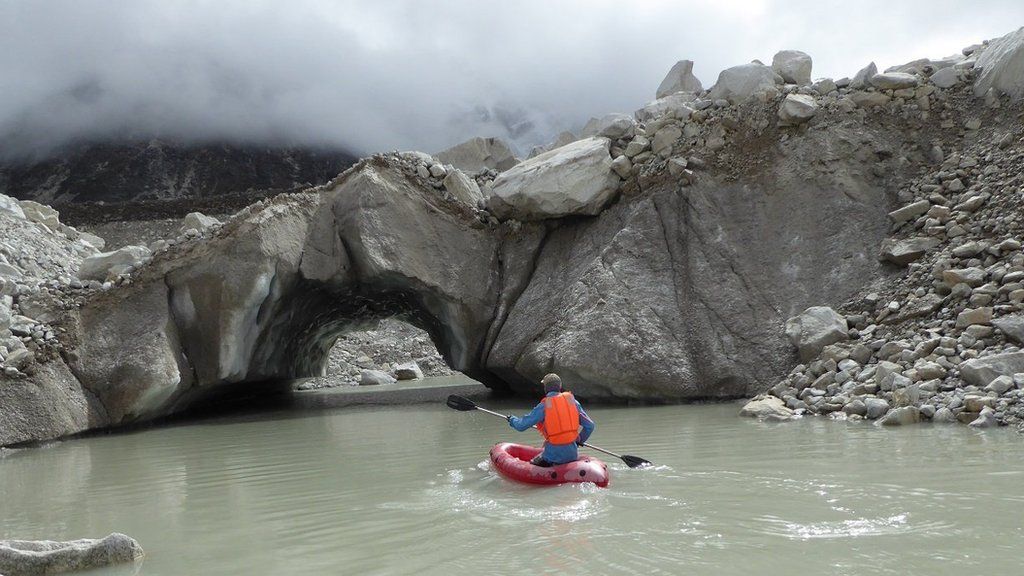
Adrian Ballinger, founder of mountain guide company Alpenglow Expeditions, said the plan to move base camp made sense, because it would see more avalanches, ice, and rock falls in the future.
The president of Nepal Mountaineering Association, Nima Nuru Sherpa said he was aware of the dangers in the wake of global warming.
“But there is no clarity on where we move the base camp to, and this is why we hardly hear any supportive voices,” he said.
The Khumbu Icefall factor
Many climbers of the Sherpa community have argued that the present location of the base camp is the best one to start their climb early in the morning as it adjoins the Khumbu Icefall, which is one of the most challenging sections of the climb.
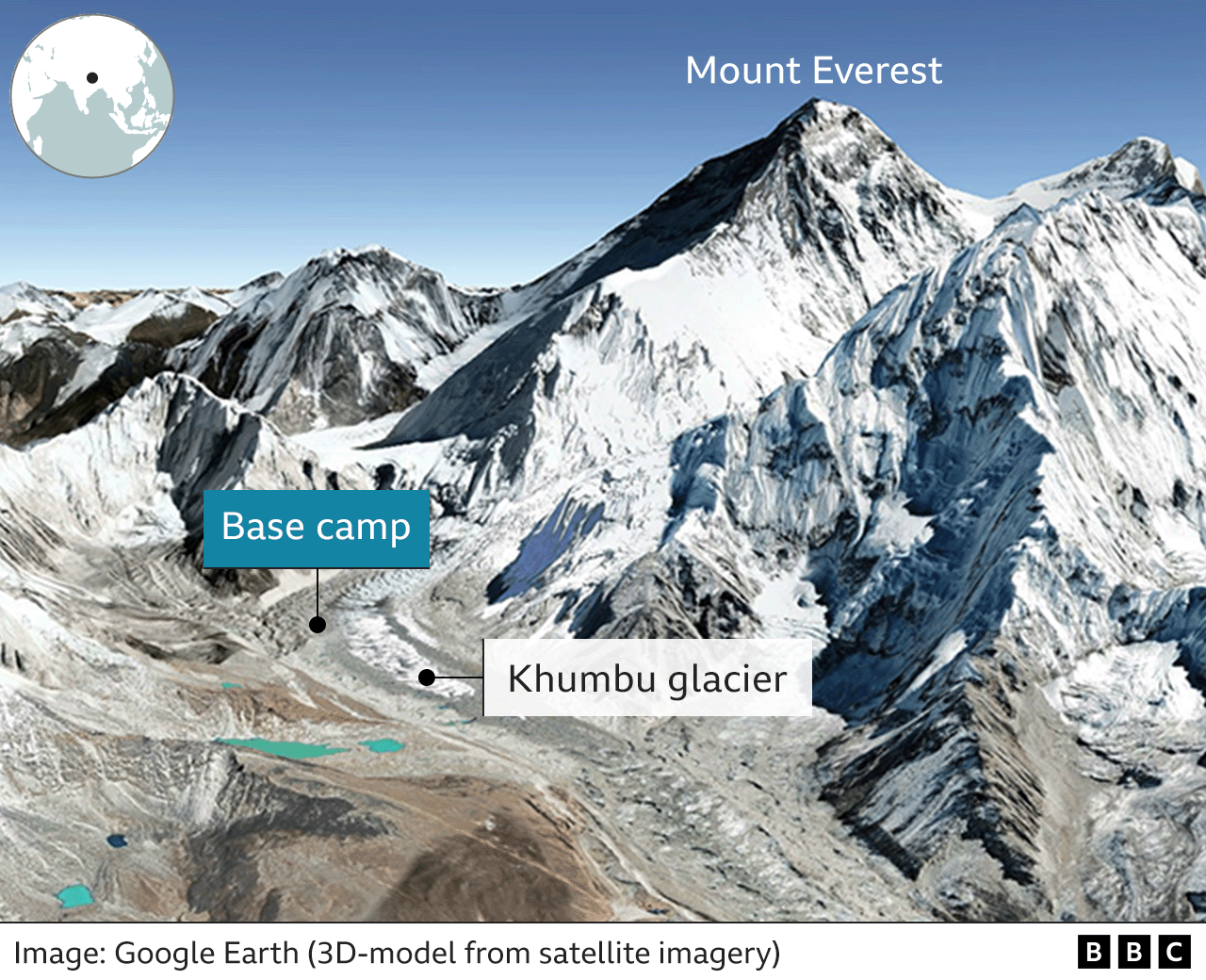
The icefall, on the South Col route to the summit of Everest, rapidly falls down the mountain opening large crevasses with little warning and dislodging huge towers of ice, known as seracs. It is also regularly hit by avalanches and rockfalls from the mountain slopes overlooking it on both sides.
Sherpa climbers say they need to cross the Khumbu Icefall early in the morning because it becomes more dangerous later in the day when the sun warms the mountain, resulting in increased avalanches, rockfalls and seracs collapsing.
“If we moved the camp to lower heights, it would mean nearly three hours of extra walk for climbers and that will delay their journey to the dangerous Khumbu Icefall,” said Mr Mingma.
Three Sherpa climbers died on Khumbu Icefall on 12 April when they were hit by an avalanche while ferrying climbing gear for their clients.
Mr Mingma said even if the base camp was moved to a lower location, most expedition teams would end up using the previous location as an advanced camp to begin their early morning climb through the Khumbu Icefall.
Lukas Furtenbach, an international expedition operator from Austria who brings his clients to Everest almost every year, says moving base camp would make the first stage of the climb too long.
“Teams would make an intermediate camp right at the current base camp location,” he said.
Crowded base camp
But almost everyone in the mountaineering industry agrees that base camp is getting too crowded.
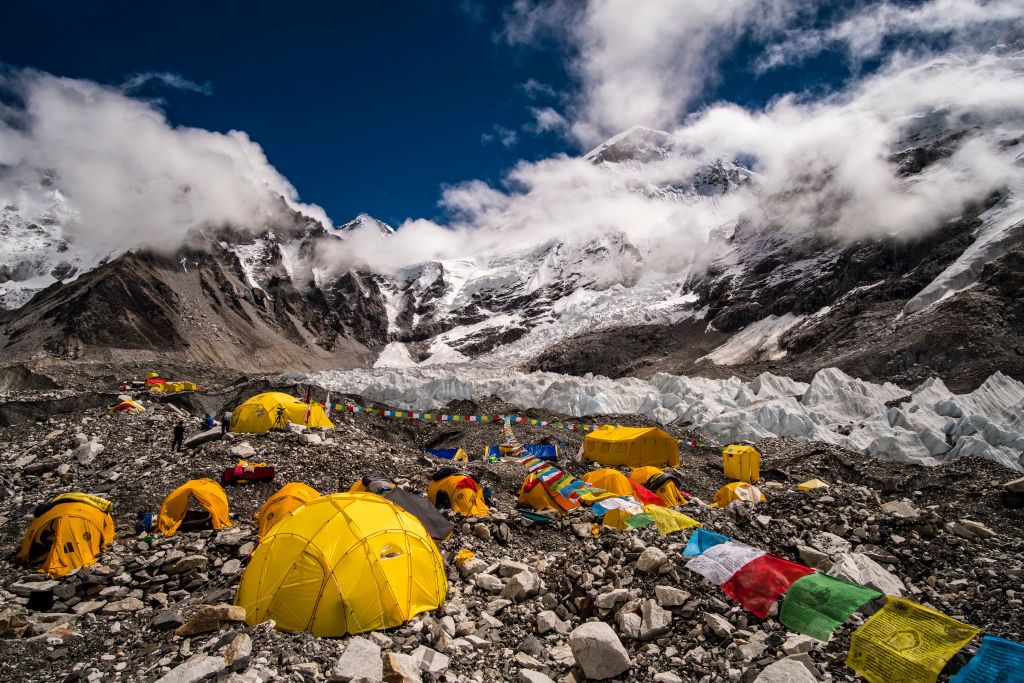
This season, Nepal issued a record 478 Everest climbing permits, which means there will be over 1,500 people on the mountain, including support staff.
The last record number of permits was 403 in 2021, according to tourism department officials. The government charges $11,000 (£8,900) per climber for Everest and expeditions are a major source of income for the Sherpa community and others dependent on mountain tourism.
“The size of the base camp has doubled over the years, it’s a massive operation,” said Dambar Parajuli, president of Expedition Operators’ Association Nepal.
He added that the growth of the camp is unregulated and poses a threat to the already fragile environment.
“You see deluxe type services like massage parlours or other entertainment services that need massive tents and other structures.
“This is not where you indulge in luxury, and we have strongly suggested the government make strict guidelines on what is allowed and what is not at the base camp.”
Minister Kirati said he was aware of the issues.
“The base camp has become like a tourist market that we see here in Kathmandu.
“This is not acceptable – we are soon going there on an inspection and will stop all that. That is our priority now.”
Related Topics
-
-
17 June 2022
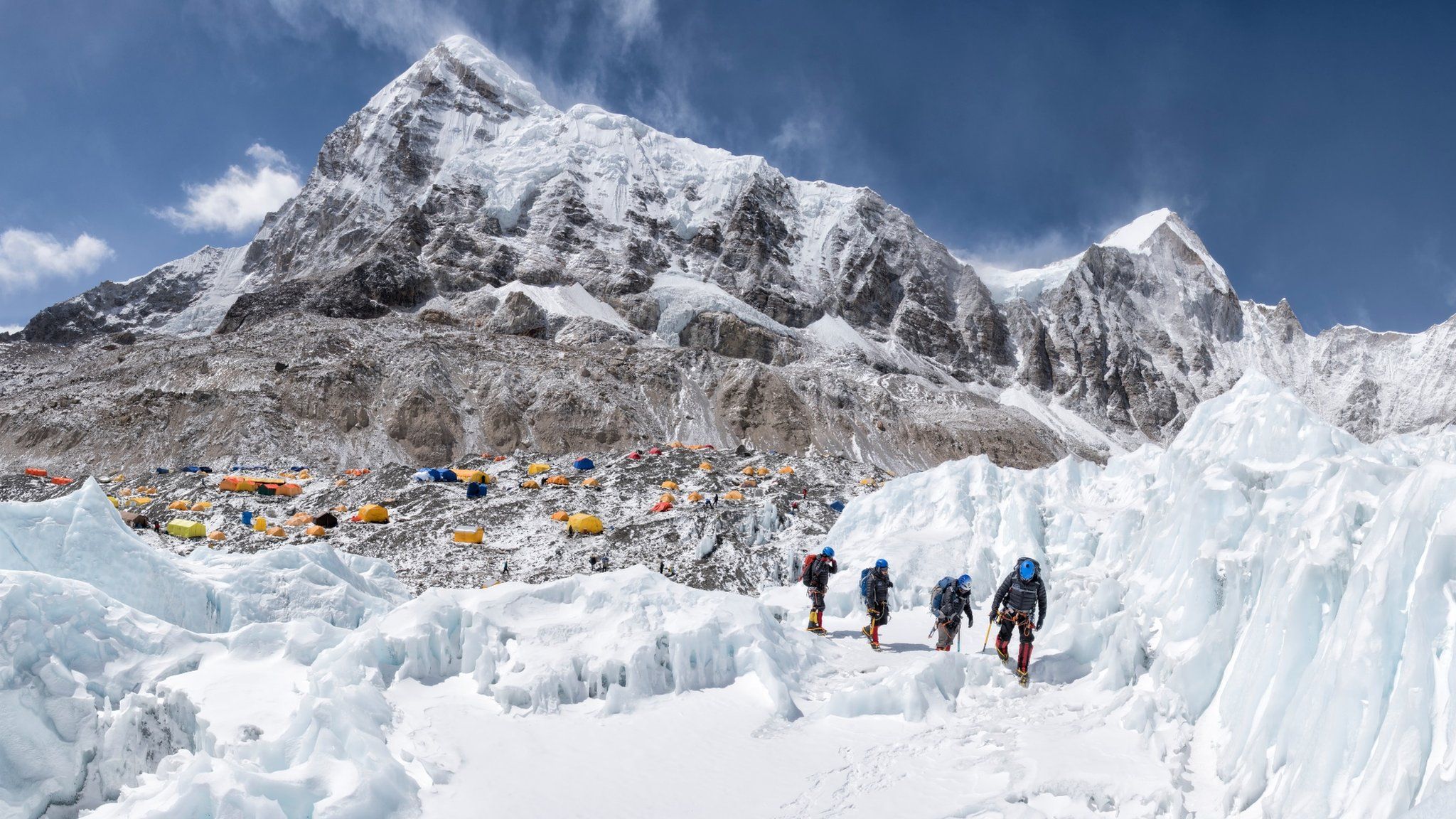
-
-
-
27 November 2015
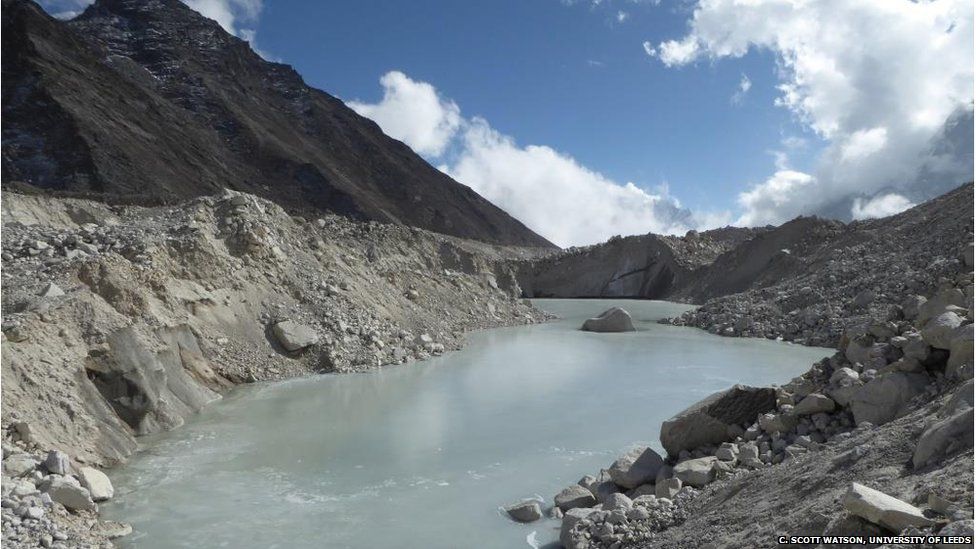
-
Temasek cuts compensation of senior management, investment team over failed investment in FTX
SINGAPORE: Temasek’s investment team and senior management “took collective accountability and had their compensation reduced” after the firm’s failed investment in cryptocurrency company FTX, chairman Lim Boon Heng said on Monday (May 29). “With FTX, as alleged by prosecutors and as admitted by key executives at FTX and its affiliates, there wasContinue Reading
From fugu to ikan buntal: Pufferfish has long roots in culture

“These folklore are important and we don’t go against it because they are the words of the orang lama, individuals who have tried and tested them,” Firdaus said.
Meanwhile, Khir told of another folklore shared by Malay elders: “If, when boiling the fish, the water gets dark and murky, it means the poison has gone into the flesh. So you cannot eat it,” he said.
While both Malay and Orang Laut cultures parlay the fish to a dish called kerabu buntal (loosely translated to mean pufferfish salad), their versions differ from one another.
For one, the Orang Laut version includes the potentially poisonous liver. “The liver becomes a rich base along with chillies, lemongrass and kangkong (water spinach),” explained Firdaus. The pounded base is cooked down with the pufferfish meat to a thickish sambal.
“While the texture of the meat – somewhat like that of Patagonian toothfish – is great, you need spices like red chillies, ginger, garlic, and lots of black pepper and lemongrass to bring out the lemak-ness (richness) of the fish,” said Khir. “We cook it down till the entire mix reduces so that it’s quite dry, hence the name kerabu buntal.”
FEWER FUGU CHEFS
With strict rules regarding its consumption in place, both in Japan and Singapore, the art of preparing pufferfish is slowly becoming one that’s limited to a few.
According to Firdaus, the number of individuals skilled at preparing pufferfish in the Orang Laut community has dwindled since fishing requires “the luxury of time” in modern Singapore. And even in Japan, Yamauchi reckoned that the rise of farmed fugu and an increasing number of Japanese fishmongers skilled at preparing fugu have led to fewer qualified fugu chefs.
Nevertheless, the fascination with pufferfish remains intact for now – whether served as a seasonal delicacy during the winter months at Japanese restaurants or even as part of yusheng during Chinese New Year. And for anyone mulling the prospect, it pays to fall back on the adage that when in doubt, sit it out.
Whistleblower won’t give up fight

The memorandum of understanding signed on May 22 by the eight parties hoping to form a governing coalition sets forth an ambitious reform agenda, including “push for reform of the bureaucracy, police, armed forces and justice system” and to “promote a culture of transparency to tackle corruption”.
They have their work cut out for them.
“The core of society is corrupt,” former politician Chuvit Kamolvisit says on the new Bangkok Post podcast, Deeper Dive.
“I believe every country has corruption when they start. But I never see any country that as time passes by, the corruption is more, is more, is more, like Thailand.”
If anyone knows about corruption, it’s Mr Chuvit. As the owner of a string of soapy massage parlours in the 1990s and early 2000s — the ab ob nuat (massage parlour) complexes that are actually fronts for prostitution, which is against the law — he claims to have paid the police monthly bribes to the tune of 3 million baht to stay open.
After selling the seedy side of his business empire, Mr Chuvit began a career in politics as an anti-corruption campaigner, twice serving as a member of parliament. Although his days as a politician have passed, he’s been back in the headlines since late 2022 with allegations of high-profile graft.
In February, he identified “Inspector Sua” as the former senior police officer behind a network of online gambling sites. Pol Lt Col Wasawat Mukurasakul and 18 associates have fled abroad, while 57 people have been arrested over their alleged links to the 10-billion-baht-a-year operation.
“There is 5,000 websites about the gambling in Thai,” Mr Chuvit said on Deeper Dive.
“They [make] them pay 50,000 per website per month. So you can calculate how much they get.
“Smaller size — 5,000 websites. Middle size — pay 100,000 per month. I divide into size S, M and L. Each size, you pay more.”
The month before, Mr Chuvit publicised the case of Charlene An, the Taiwanese actress in a group that was stopped at a Bangkok police checkpoint on Jan 4 and allegedly only released after they paid 27,000 baht.
“When Charlene comes with the Singaporean, takes the Grab past the checkpoint, the police know this is a tourist, so they stop and check and found the electric cigarette, which is illegal in Thailand. This is a gap for corruption, [because] you can buy the electric cigarette everywhere, in the market, on the street, online.”
Ignorance of the law, Mr Chuvit pointed out, is no defence — and enforcement can be lucrative.
“You’re not a local, you’re a tourist, you don’t know the rule, you need to go to jail. This is the way the Thai police do [it].
“The checkpoint is always on the main road, near the entertainment area, for example on Sukhumvit, on Ratchada, on Thong Lor, on Ekkamai. The small police officer needs to find money to send to the higher police, because they set the target every time you set up the checkpoint.
“They see you, they stop you, they know you are farang, you’re not a local. Let’s say…you’re drunk. What you gonna do? You gonna go to jail? Or you just pay me 20,000, 30,000.”
Mr Chuvit emphasised that not all officers are corrupt, saying almost all of his information comes from whistleblowers inside the Royal Thai Police. “You are surprised or not? There is still good police… They send me the video, they send me all the secret information.”
‘buying the law’
The case that brought Mr Chuvit back into the headlines was the Oct 26, 2022 police raid on an unlicensed club in Yannawa district. He wrote on Facebook that a group of Chinese nationals found on the drug-strewn premises paid 5.5 million baht to avoid arrest, while another 11 who escaped the raid were asked for a further 4 million baht by police, Department of Special Investigations personnel and a soldier.
Mr Chuvit said the amounts were so large because police knew they had caught some big fish.
“If you file the red notice, you can check from Interpol, it’s a jackpot. Now you have to pay me! They know that Chinese always carry cash, they have a society so tight. So they can make a call and ask for more cash.”
Many of the Chinese, Mr Chuvit discovered, were on visas issued fraudulently in the Northeast.
“Why you have to go to Isan? Immigration Section 4 — northeastern Thailand area. So I can check…7,000 Chinese apply for volunteer, education [visas] in Section 4 in the year 2020, 2019 only. Different from another section. So I know: this is strange.
“Criminal of China, where they want to go? Cannot go to Singapore, cannot go to Australia. They go to Thailand. Why Thailand? Because Thailand easy…they can buy the police. They can buy the law.
“They can do anything.”
In an interview with the Bangkok Post published on 17 Feb 2023, Pol Gen Surachate Hakparn, deputy national police chief, confirmed many of Mr Chuvit’s allegations, including that corrupt immigration officials appeared to be issuing education and volunteer visas to Chinese gangsters in the northeast.
“The IB [Immigration Bureau] is bound by duty to prevent those criminals from slipping through immigration controls,” he said. “But as it happens, some immigration officers are suspected of facilitating their entry into the country.”
“When I served as the IB chief, thousands of overstayers, many of whom were criminals, were arrested and deported. Right now, they are returning and trying to secure student or volunteer visas for a longer stay of up to one year with the help of corrupt immigration officers.”
In this and several other cases, it appeared that Mr Chuvit was doing the police’s work for them — begging the question whether these cases would ever have been investigated had he not brought them to light. Whether the cases eventually lead to convictions or any meaningful change, however, is doubtful given past history.
After the scandal erupted, Pol Lt Gen Pakpoompipat Sajjapan, head of the Immigration Bureau, promised “a working group to revise rules on visa extension applications that cite work for foundations, the need to receive medical treatment, and for studying in both the formal and informal educational systems”.
A common perception, however, is that the problem is not the rules: it’s that criminals are bribing officials to flout the rules.
Foreigners living legally in Thailand bring billions of baht into the economy. After corruption scandals emerge, it appears that authorities’ kneejerk response is to tighten bureaucratic red tape for these legitimate foreigners — ironically creating new corruption opportunities — while foreign criminals continue finding ways to bribe their way in.
In this way, authorities can make it look like they’re tackling the problem, such as by tightening restrictions on visa applicants, instead of dealing with the true cause — corruption and crime in their own ranks.
Culture of dishonesty
For Mr Chuvit, the underlying cause of Thailand’s corruption is a culture of dishonesty.
“The core of the society is corrupt… They always say that it’s a Buddhist country. But it’s wrong. They don’t accept the truth. There is prostitution in the middle of Bangkok, in the massage parlour, everybody knows. But the law forbids it.”
Some corruption can be addressed, Mr Chuvit suggests, by legalising and taxing grey businesses such as gambling and prostitution, using some of the proceeds to top up the salaries of underpaid junior police to make corruption less tempting.
“If everything like gambling on the table, you can take the corruption out and you can bring the money from the tax, which I call sin tax, to generate benefit for all the police, all the justice [system].”
In his next breath, however, the maverick campaigner says it will never happen, because the people in charge are the ones that benefit most from corruption.
“They’re not gonna do that. Believe me. Why? Because they don’t want to eat on the table. They want to eat under the table. You can eat more — greedy! If you eat on the table, you have to eat formally. But if you eat under the table, you can eat anything! You can eat a lot!
“You see, this is the Thai way. They don’t do it in front of you, they do it behind you. That’s why you see more corruption in Thailand …They like to lie.
“If they accept the truth, this country [would go] forward. And grow. A lot.”
The transformation of the self-described “superpimp” into a heroic whistleblower invites scepticism in many quarters.
Aside from his past involvement in grey businesses and mafia-like activities such as the overnight demolition in early 2003 of bars and shops from Sukhumvit Square — which he had recently purchased, and for which he served time in prison — Mr Chuvit has himself been accused of corruption.
Others chafe at his self-portrayal as a victim and a martyr, such as when he told me: “I sacrifice myself to let Thai society know what happened”.
Yet arguably no-one else has done more to expose corruption in Thai institutions in recent years.
And whether or not his claim that his 2003 revelations of bribery led to his abduction for two days is true, the May 11 death in police custody of a sidekick to Inspector Sua — who would have been able to identify many of those involved in the online gambling ring — is a reminder that knowing too much can be dangerous.
Most of all, perhaps, his message that the best way to fight corruption is to speak up, loud and clear, is quite persuasive — even if the consequences could be dire and the odds of victory seem oppressively long.
“You need to talk, you need to speak up. You need to [make them] aware, at least [then] they are afraid to be corrupt.
“You may say that I not win. I say that I not win. I am just sparking the light. And with one candle, maybe I not win today. Maybe I win next year. Maybe I never win. But at least I talk, at least someone try to do.”

Scan the QR code or visit http://bit.ly/3MEMAGS to watch Dave Kendall’s full interview with Chuvit Kamolvisit on the second episode of the new ‘Bangkok Post’ podcast, ‘Deeper Dive’. Or search for ‘Deeper Dive Thailand’ wherever you get your podcasts.
Commentary: Is kampung spirit so broken that Singapore authorities must enter homes to resolve neighbour disputes?

Sometimes, it is a matter of a lack of awareness. Once, I texted a neighbour to gently remind her that her karaoke session was getting a little loud late into the night. That was sufficient for her to stop with a “Sorry! I didn’t realise it was so late!”
I was able to do that because we practise neighbourliness. We chat and exchange pleasantries as friends and acquaintances.
However, usually when cases reach the mediation stage, it is often a situation where neighbourliness has already withered (or never blossomed in the first place) and the parties are not prepared to talk it out.
In such situations, it is common that the complainant resorts immediately to reporting the matter to the police or such similar authority without first reaching out to the respondent. Other times, the complainant does reach out to the respondent, only to be ignored or stonewalled.
There is an issue with mediation in its current form: Mediation cannot move forward if one or both parties are not interested in addressing the situation.
At the moment, mediation cases are voluntary; there is no law to compel it. Yet mediation requires both sides come together to work out a solution.
Of the 6,095 voluntary mediation cases registered with Community Mediation Centre (CMC) in the past five years, 77 per cent did not proceed to mediation. Reasons include, among others, either party ignoring or declining CMC’s invitation to mediate.
Yet, when these cases get mediated, the success rate goes up: Up to 80 per cent of cases that proceed to mediation reach a settlement after parties hear each other out.
Commentary: Warren Buffettâs intriguing bet on Japan

THE CURRENCY FACTOR
The foreign currency earnings of the sogo shosha, backed by hard commodities from sources around the world, set the trading groups apart from companies with revenues and costs that depend more heavily on prices in domestic markets. They create multiple ways for Buffett to profit from his investment, even if the trading companies’ vaunted plans to reinvent themselves for a world without fossil fuels do not proceed as planned.
Among the most tantalising is the fact that Buffett has bought shares in companies that earn a portion of their profits in dollars, while funding his purchase with long-term debt denominated in yen.
If the Japanese currency were to depreciate, the dollar value of Berkshire’s outstanding yen-denominated debt would fall. At the same time, the value of the sogo shosha stakes in dollar terms may not decline so much because of their foreign currency earnings. If the value of the debt falls more than the shareholdings, then Buffett could reap a profit even without much change in underlying business performance.
It is surely not Buffett’s intent to bet against the yen. And using borrowed money to buy stock in companies with significant foreign earnings is not, of course, the most practical way to do this. Set that misgiving aside, if only for a thought experiment, and you can see how a trade like Buffett’s might in theory look attractive to a very different kind of investor.
Speculators of an atavistic bent are eyeing the monetary institutions of the developed world with increasing suspicion. Gold is trading near all-time highs, and while a rupture in the systems of economic exchange may not be anyone’s base case, it lies uncomfortably close to the universe of historical possibility.
Ray Dalio, the Bridgewater founder whose investments are informed by a close reading of economic history, notices a striking pattern in the rise and fall of the “reserve currency empires” of the past 500 years.
Throughout that time, he writes, “seismic shifts always took the form of too-large debts that couldn’t be paid with real money so there was a lot of printing of money”. That, in turn, “led to big debt restructurings via writing down and monetising debt”.
They’re young, but they’re no rookies: More kids in Singapore playing chess competitively

SINGAPORE: A chess game may seem still and silent from the outside, but when nine-year-old Alesa Wong is battling an opponent for control of the board, her mind fills with “blasting colours”.
“There are a lot of noises inside a chess player’s mind, just that nobody can hear it,” the junior chess player told CNA. “It’s extremely exciting, and my heartbeat races when I know I’ve made a brilliant move.”
Alesa, who started playing chess when she was seven, is part of a newly established national training programme for young chess whizzes.
In the past months, the influx of young minds to Singapore’s chess community has become more noticeable.
A record 1,365 players competed in the 74th National Schools Individual Chess Championship in March. There could have been more, but some would-be competitors were turned away as the venue was not big enough.
Then in April, the Singapore Chess Federation launched the national training programme to nurture the country’s next generations of chess talent.
The programme comprises an under-10 squad with 14 members and an under-14 squad with 18 members. The youngest of the entire bunch is six-year-old Lucas John Wee.
Fidgety young Lucas becomes serious and focused when he is playing chess – a part of his personality that his family usually does not get to see, his mother said.
When asked why he enjoys playing chess, Lucas said simply: “I get to relax.”
That may be surprising to hear considering he trains for 10 hours a week. Other children in the squad can spend up to 16 hours a week on chess, with thrice-weekly sessions under the national training programme, one-to-one private coaching and self-study.

